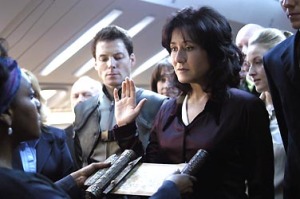The myth of the “superwoman” pervades American society on many, even everyday levels. This is particularly evident if you scan the magazine rack while checking out at the supermarket. Magazines proclaim that it is possible to be a kind of “superwoman” who has everything – the perfect figure, the powerful job, the great husband, the active sex-life, the approximately 2.5 organically-fed, perfectly coiffed children and pristine pooch. She is fashionable, beautiful, a great cook, the ideal mother, the perfect hostess, but she also knows the “75 Very Naughty Moves to Try on a Man” (Cosmo). It doesn’t hurt for her to be busty and cellulite-free, either. One of the latest issues of O Magazine suggests that readers can have “your ideal body, a better job, extra energy, more love, less stress, [and] a fresh outlook” if only they open up this special “Make Your Dreams Real” issue. Shape Magazine’s February 2011 cover declares that five ways to beat your winter blues reside “inside your makeup bag.” I suppose this view of women is more faceted than that of the 1980s tough, childless woman executive image, but…both seem equally ridiculous.

Clearly, the people marketing magazines think that women can truly “have it all!” But where did this idea of “having it all” even originate? I hadn’t given it much thought until I came across an anecdote in some of my research. Turns out, the phrase was popularized by the editor of Cosmopolitan magazine (from 1965-97), Helen Gurley Brown, when she published her book Having it All in 1982. After JStoring my way through a bunch of reviews of Gurley Brown’s work, it seems like academics are mixed about her books. While she did a lot in the 1960s to advocate for women’s sexual liberation, she went too far when she suggested that women use business lunches as excuses to get dates with men in the office, and that women should use their sexuality without a second thought to get ahead at work.
Interestingly, the idea of extra pressure on women to be more than just career woman, fighter or mother is not unique to the print media either, but appears to be a wider social concern in current western society. Lillian S. Robinson points out that “in real life, nowadays, we’re using another word from the comic book lexicon, Superwoman, to characterize someone who is a competent professional and a competent homemaker and mother” (Robinson, 20). She furthers her argument by noting that this term often excludes those of a certain class or race. She states “that heroic epithet is rarely applied to a woman raising a houseful of kids on her earnings as waitress or a switchboard operator or a domestic servant…you seem to earn the “Super” label if you are not only able to do it all superbly, but if you have to do it all” (20). This kind of perfect ideal is rare in real life, but even rarer in the form of an onscreen virago –there is only one primary example of a virago who is a mother, a waitress and a warrior, and she is Sarah Conner from the Terminator series. 
Additionally, an interesting opinion piece in the New York Times from 1991 Marin Gazzaniga points out that “Most families need two incomes, yet employers still act as if the man is the breadwinner, and the woman is just doing the career thing to boost her self-esteem or to do something until she has babies. Until “working father” is part of our vocabulary, Superwoman will remain. She may be haggard, but she’ll still be struggling to do it all — because somebody has to.” I find it interesting that she brings up the idea of a “working father,” and this plays into my next point: with superwomen come super-expectations. The virago, like other women in our society, is expected to be any number of idealized personalities. What intrigues me the most is not the fact that she “should” be so many personalities, but that she often works as a multiple sign (aka, she hold multiple identities), which actually makes her stronger and more complex as a character as opposed to the typically stable and less complex sign system of the male hero. Although it is easy to think of examples of the personalities that women must have, our society tends to think of men in general (but especially the male hero) as less complex sign systems. This is why the idea of being a “working father” just doesn’t come up on a regular basis – the business man is the business man, he is not generally made into a bizarre super-category of “business man/father/husband/sex god/great cook/excellent host/etc.” This sign mulitiplicity plays out in a number of ways for the virago– because she can whip identities on and off quickly, her character can literally do things and go places that male heroes cannot.
But let’s take a look at how the male action hero works in general, as a stepping stone to how the virago works. In my experience, heroes (as opposed to viragoes) tend to be embodied in the following ways.
He:
1. Is in control of his body and rarely “vivisected” on screen.
2. Rarely uses sex/seduction as a means of getting what he wants.
3. May use disguise but rarely employs a sexually-motivated disguise
4. Is hardly ever accompanied by children.
5. Has a single, stable identity and sign system.
6. Is rarely defeated through emotional manipulation.
7. Often kills without experiencing any ramifications.
8. Hardly ever works with others and is extremely independent.
Viragos tend to be the opposite of this list.
(For sticklers, it then makes her:
1. Rarely in control of her body and is often “vivisected” on screen.
2. Often uses sex/seduction as a means of getting what she wants.
3. Often employs a sexually-motivated disguise.
4. Accompanied by children much more frequently than the male action hero.
5. Does not have a single, stable identity and sign system.
6. Is often defeated through emotional manipulation.
7. Rarely kills without experiencing any ramifications.
8. Often works with others and may be less independent than the male action hero is typically.)
The above qualities (and probably a million more that I have not thought of and/or listed – feel free to share your imput) are part of what makes the male action hero so easy to spot and part of what makes him so likeable. He is predictable and stable. The virago, on the other hand, is anything but stable, as sign systems go. I personally feel that the lack of stable qualities to the virago is a double-edged sword – while she is flexible to be whoever, wherever, whenever…this is also the quality that makes her irritatingly hard to put your finger on and it can be difficult to both spot and identify with her. I personally feel that her instability as a stock character makes her less likeable (because she is less predictable), although you are free to feel differently. The other danger of being a multiple sign system in this particular case using the above strictures of the male hero in reverse, is the fact that some of her instability comes from the fact that she can switch identities between person and object through the course of a film, for example (see rules 1,2, 3 of the male hero).
Join me next week!
Mishy
Works Cited:
Robinson, Lillian S. Wonder Women. New York: Routledge, 2004. Print.
Suggested reading:
Fascinating article about perceptions and expectations of women in the workplace in the 1940s-60s:
“The Joy of Work: Helen Gurley Brown, Gender, and Sexuality in the White-Collar Office.” Julie Berebitsky. Journal of the History of Sexuality. Vol. 15, No. 1 (Jan., 2006), pp. 89-127 Published by: University of Texas Press. Article Stable URL: http://www.jstor.org/stable/4617245
An article about the breakdown of topics in Cosmo:
“The “Cosmopolitan” Ideology and the Management of Desire.” Kathryn McMahon. The Journal of Sex Research. Vol. 27, No. 3, Feminist Perspectives on Sexuality. Part 2 (Aug., 1990), pp. 381-396 Published by: Taylor & Francis, Ltd. Article Stable URL: http://www.jstor.org/stable/3812809
Images from here and here.
Tags: semiotics, sign systems, social perceptions, virago, virago rules, vocabulary









